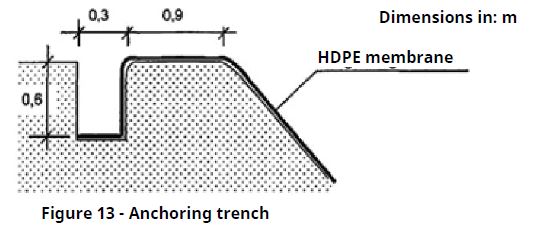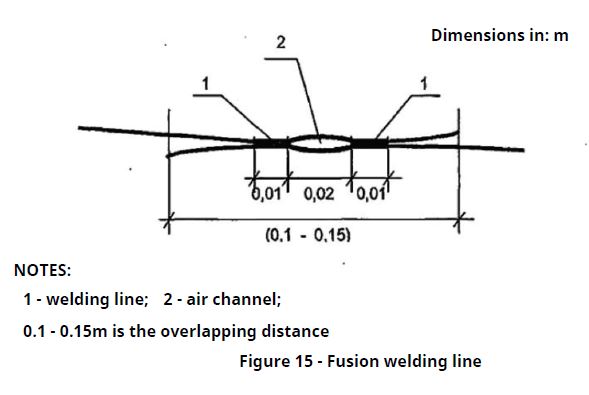HDPE Geomembrane Construction Project Preparations
1. Preparing before construction:
1.1 Material Requirements:
The HDPE geomembrane wrapped well before being shipped to the construction site needs to have the following technical documents:
– Quality control certificates issued by the manufacturer.
– The test results of the standard laboratories (as a comparison document with the manufacturer’s test report) and the certificates confirming that the geomembrane meets the requirements for product quality.
– Instructions for transportation, delivery, storage, loading and unloading of the geomembrane. – Installation instructions for geomembrane.
1.2 Technical requirements in transporting, loading & unloading, preserving the geomembrane at the construction site:
– To avoid damage due to mechanical impact and weather, the geomembrane needs to be transported from the storage and production site to the construction site by specialized vehicles.
– The movement of geomembrane rolls from the gathering place to the installation location must be done by suitable equipment, avoiding damage to the ground, puncture of the geomembrane rolls and dragging on the ground.
– The loading and unloading equipment is not allowed to use steel cable but must use flexible cable in textile form.
– The place to gather geomembrane rolls at the construction site must be carefully selected and covered to avoid rain and sun. Avoid using areas with potential burning and explosion risks, storage of oil, grease, dirt, mud and water. And this place should be convenient for transporting to the installation site.
– Do not stack geomembrane rolls more than 3 layers.
1.3 Technical requirements for construction equipment, equipment for acceptance at the site:
1.3.1 Requirements for construction equipment:
Construction equipment includes: Fusion weld machine, extrusion weld machine, hot air blower, grinding machine and other auxiliary equipment and tools.
– Fusion weld machine must have meter and control of welding temperature, compression pressure and welding speed. The welding seam must ensure a smooth air channel to facilitate acceptance by pressure testing, the horizontal section of the fusion welding seam is shown in figure 15.
– Extrusion weld machine must have a meter and temperature control at the extrusion head, the size of the extrusion weld is shown in Figure 16.
– During construction, there must be enough backup machines and spare parts to ensure continuity, meeting the construction plan and schedule.
1.3.2 Requirements for construction equipment:
Construction equipment includes: lighting system, equipment for lifting, moving, spreading membranes, generators, these devices must be equipped with means of fire prevention and safety measures in case grease leaks onto the surface of geomembranes. It is not allowed to use sprocket vehicles but must be replaced with rubber tires.
1.3.3 Requirements for construction equipment:
Bamboo or wooden stakes, sand sacks, rope ladders, measuring tapes, cutting tools, specimens for marking distances, white paint pens (eraser), pulling tools such as pullers, pliers, ropes, membrane surface cleaning tools: soft cloth, sponge.
2. Requirements during construction process:
2.1. Surface technical requirements before spreading the membrane:
a) The surface before applying the membrane must meet the following technical requirements:
– Flat, smooth, firm, and free of water.
– All materials that are likely to cause damage to the membrane must be removed.
– At positions where the slope changes, it must be rounded at least to a radius of 0.15m.
b) Anchoring trench:
– If there is no design detail, the shape and size of the anchoring trench must be constructed as shown in Figure 13.
– The edge of the anchoring trench in contact with the membrane must be rounded to avoid tearing the membrane when stretched.
– As the geomembrane is installed, the soil must be properly poured into the anchoring trench.
– Soil poured into the anchoring trench must be compacted according to design requirements but at least K> 0.9

2.2. Steps to prepare membranes before installation:
– Choose a flat, smooth ground, wide enough to gather the membrane rolls and make the installation panels. Choose the position to install the first membrane sheet and determine the direction to install the next sheet.
– Draw an installation diagram on the construction log including the installation order, position and size of each sheet (numbered in order)
– Measurement data from the field is transferred to the place of gathering and creating panels. After fabrication is completed, the parameters are written directly on the surface of each membrane roll and then arranged in the order of installation waiting to be transported to the installation off-site.
– During storage at the construction site and during construction and installation, it is necessary to minimize the time when the HDPE membrane is exposed to sunlight, otherwise, it will affect the service life: it is necessary to take covering measures.
2.3. Installation (membrane sheet spreading):
a) General principles:
– Laying membrane sheets on slopes: Panels must be parallel to the direction of the slope (the weld seams between the panels must also be parallel to the direction of the slope). The bottom edge of each panel must be at least 2m from the base of the tray.

– Spread the membrane sheet on a flat surface:
On the plane, the sheet can be spread in any direction, however, the total length of the seams must be shortest.
– At the corners: Spread the membrane sheets according to figure 14.
b) Overlapping distance:
The overlapping distance according to the pre-marked position of the manufacturer. For products that are not pre-marked with overlapping distance, use the specimen to mark. The overlapping distance between the sheets depends on the requirements of each type of welding machine, usually from 100mm to 150mm.
2.4. Technical requirements for soldering:
2.3.1. Welding diagrams:
a) Fusion welding line:

b) Extrusion welding line

2.4.2 Test welding:
a) For fusion welding machine:
– Right at the construction site, cut 2 sheets 5m long, 0.3m wide, select the parameters for the welding machine including: temperature, speed and compression pressure. Operate and wait for the machine to stabilize and then proceed to weld 2 prepared sheets together to get a test weld sample, after the weld sample cools down, remove the two ends of the sample, use a mold or cutting tools (ruler, square, scissors) to make 10 test samples with the size of each sample: 0.025m wide x 0.15m long.
– Take 5 tensile test samples and 5 peel resistance test samples on portable tractors at the construction site.
– Compare the average value of each test type with Table 2. If the tensile strength and peel resistance are equal to or greater than the values given in Table 2, the joint is considered to be satisfactory and the chosen parameters (temperature, speed, compression pressure) will be applied to the welding machines of that shift and will be maintained for the next test welding. If not, adjust the parameters for the welding machine and try a new sample.
b) For extrusion welding machine:
Do the same as fusion welding, but the weld length is 1m.

3. Safety work and environmental protection during construction:
3.1 General provisions:
– Before construction, it is necessary to thoroughly investigate and survey the topography, geology, and hydrology at the construction site. Forecasting in advance weather conditions such as rain, storms, tornadoes in order to take preventive measures to ensure the safety of people, construction equipment, materials, fuel, material storage as well as the property of local residents.
– Measures to ensure work safety, health protection, fire and explosion prevention, and disease prevention must be implemented based on current regulations.
– An investigation must be conducted to locate underground pipelines, underground power lines, and underground optical cables within the construction area to take measures to ensure safety for these underground works during construction.
– Measures must be taken to minimize adverse impacts on the ecological environment, especially for the treatment of waste generated by the construction process in order to avoid soil and water pollution, especially groundwater.
3.2 Safety requirements in construction:
– Anyone involved in the construction is required to attend a work safety course trained by the site safety committee.
– Anyone involved in the construction must be equipped with protective gear including: clothes, shoes, socks, glasses, safety belt.
– Temporary roads and temporary bridges must be warned with signs to guide traffic participants.
– Foundation pits, talus edges, trenches for laying underground pipes, and underground cables must be surrounded by fences and warned with danger warning signs.
– Construction machinery equipment using electricity must be equipped with safety engines such as voltage stabilizers, automatic disconnectors. Machinery using petroleum, gas needs to be equipped with fire prevention equipment such as fire extinguishers, sand, water.
– A lighting system must be provided during construction at night.
3.3. Environmental protection requirements:
– Measures must be taken to prevent soil pollution, water pollution, and landslides.
– Measures must be taken to treat waste and domestic waste, especially waste containing grease and oil.
– Measures must be taken to prevent air and noise pollution.

- Số 28, Tổ 4, Ấp 3, Xã Lương Bình, Huyện Bến Lức, Tỉnh Long An, Vietnam
-
Tax Number
1101794801
Contact Us
- +84 937715638
-
090 818 3628
090 818 9628
093 771 5638 - info@KietKiet.com